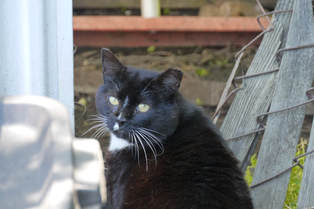 Nearly one million healthy cats and kittens are euthanized annually at shelters across the country. Of these healthy cats, feral cats often face the bleakest outcome. This is because feral cats are born and raised in the wild and are generally unsocialized towards people. Feral cats are not good candidates for adoption; they often hide in the back of their cages and do not seek affection from people. Thankfully, trap-neuter-return (TNR) provides an answer to a near certain death for feral cats. TNR involves trapping the cats, providing them with spay/neuter surgery and vaccinations, and returning them where they were found outside. The cats are ear-tipped to identify those who have gone through the TNR process. TNR’d cats will have a colony caregiver who will provide them with continued food, water, and veterinary care. This method humanely handles cat overpopulation, while allowing the cats to live out their lives. TNR acknowledges that feral cats are unsuitable for indoor living and at the same time, helps shelters reduce their intake and euthanasia rates. Furthermore, the number of cats living in outdoor colonies will decrease over time because the cats can no longer reproduce. TNR is not only the most humane option but the most practical. Trap-and-kill plans have proven to be ineffective because these plans do not address the root problem of reproduction. A study in Tasmania found that killing feral cats actually led to an increase in population. Researchers stated that this was probably due to new individuals taking over the area after dominant cats were removed[1]. TNR is also much less costly than trap-and-kill plans. One reason TNR is more cost-effective is because it reduces shelter intake and shelter euthanasia, saving local governments’ time and resources. Lastly, TNR also helps curb problem behaviors such as wandering, howling, spraying, and fighting that eradication plans do not address; again, because TNR focuses on reproductive/mating issues. TNR Reduces Shelter Intake and Euthanasia Rates
TNR Reduces Colony Size
[1] Lazenby, B.T., Mooney, N.J. & Dickman, C.R. (2015). Effects of low-level culling of feral cats in open populations: a case study from the forests of southern Tasmania. Wildlife Research, 41(5), 407-420. [2] Scott, E. (January 19, 2012). Trap, Neuter, Return Program Decreases Homeless Feral Cat Population. Retrieved https://springfield.wusa9.com/news/news/89821-trap-neuter-return-program-decreases-homeless-feral-cat-population. [3] Trap-neuter-return. (n.d.). Retrieved from http://www.faastexas.org/. [4] Levy, J.K., Isaza, N.M. & Scott, K.C. (2014). Effect of high-impact targeted trap-neuter-return and adoption of community cats on cat intake to a shelter. The Veterinary Journal, 201(3), 269-274. [5] Cleveland, C. (March 24, 2017). FOTAS: ‘Rigorous’ community cat diversion program solution to shelter intake issue. Retrieved from https://www.aikenstandard.com/news/fotas-rigorous-community-cat-diversion-program-solution-to-shelter-intake/article_77140b66-0f1a-11e7-a197-af86f1a48d73.html. [6] Edinboro, C., Watson, H. & Fairbrother, A. (2016). Association between a shelter-neuter-return program and cat health at a large municipal animal shelter. Journal of the American Veterinary Medical Association, 248(3), 298-308. [7] Levy, J. K., Gale, D.W., and Gale, L.A. (2003). Evaluation of the effect of a long-term trap-neuter-return and adoption program on a free-roaming cat population. Journal of the American Veterinary Medical Association 222(1), 42-46. [8] Hughes, K.L. & Slater, M.R. (2002). Implementation of a feral cat management program on a university campus. Journal of Applied Animal Welfare Science, 5(1), 15-28. [9] Trap-Neuter-Return. (n.d.). Retrieved from http://www.feralcats.com/tnr/. [10] Natoli, Eugenia, et. al. (2006). Management of Feral Domestic Cats in the Urban Environment of Rome (Italy). Preventative Veterinary Medicine, 77, 180-185.
5 Comments
Temo Conde
3/12/2018 01:42:03 pm
There are 4 cats in my neighborhood that we feed, its a mom and 3 kittens, it looks like the mom is pregnant again and one of the kittens. can someone help us, not sure what to do about the pregnant cats, we love them and love to feed them, we also let them sleep in out garage, Thanks, my cell is 602-721-1971 we leave in Phoenix AZ 85029
Reply
Elizabeth Johnson
4/10/2018 02:59:51 pm
I have a stray with a possible bladder infection is there any way to get help for her
Reply
1/2/2020 10:20:07 pm
This may be one of those rare dietary supplements that can be beneficial even to sendentary people. So let’s figure out what Creatine is and why creatine for women or men makes sense
Reply
Leave a Reply. |
Details
AuthorAlley Cat Rescue is leading in the way in promoting humane and compassionate care for ALL cats. Archives
April 2024
Categories
All
|
 RSS Feed
RSS Feed